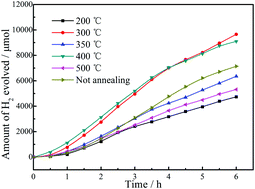Insight into the factors influencing the photocatalytic H2 evolution performance of molybdenum sulfide†
Abstract
Molybdenum sulfide has become a promising non-precious material for electrochemical and photocatalytic hydrogen production from water, while the key factors governing its catalytic activity still need to be identified to obtain molybdenum sulfide with high catalytic activity and good stability. Herein, to find the main factors affecting the photocatalytic hydrogen production performance of molybdenum sulfide, five T-MoS2+x (0 ≤ x ≤ 1) samples were prepared by calcinating amorphous MoS3 at different temperatures (T = 200, 300, 350, 400, and 500 °C) under a N2 atmosphere, and characterized by XRD, SEM, TEM and BET techniques. In addition, photocatalytic hydrogen production was carried out by using Erythrosine B sodium salt (EB) and triethanolamine (TEOA) as a sensitizer and sacrificial agent, respectively. The results showed that the change in calcination temperature leads to significant alterations in composition, morphology, crystallinity and specific surface area (SSA), and the sample 300-MoS2+x obtained by calcination at 300 °C possesses the highest H2 production performance of 1923.5 μmol h−1 under optimal conditions of 7.5 mM EB, 10 vol% TEOA and pH 9.0, which is about 1.6 times that of the precursor MoS3. Through detailed analyses of XRD, SEM, TEM, and BET results and hydrogen production performance, we proposed that the SSA and composition are the key factors influencing the photocatalytic performance of MoS2+x, and high crystallinity is bad for the performance. On the whole, the sample with small granularity, large SSA and a composition of amorphous MoS2 or MoS2 nanocrystallites exhibits better performance for hydrogen production. Comparatively, MoS2 nanocrystallites are much more stable than amorphous MoS2 in the photocatalytic reaction process.



 Please wait while we load your content...
Please wait while we load your content...